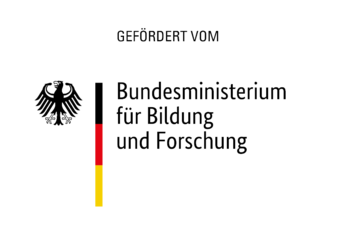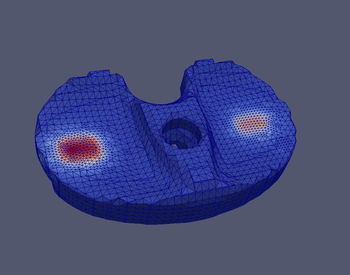Wear simulation and shape optimization of knee implants. Subproject 4: Uncertainty quantification
Evgenia Youett
Bundesministerium für Bildung und Forschung (BMBF)
One of very common surgeries daily performed in German clinics is the human knee joint replacement. For the market admittance of joint implants, standardized wear tests has to be performed. During the design phase, similar tests are necessary as well. Those tests are very cost and time expensive.
The project aims at the development of simulation and optimization methods for substituting some of the design phase tests by numerical simulations. Additionally, the design process shall be accelerated by shape optimization, and the offered implants be tailored to the patient population by taking different patient groups into account.
Other subprojects:
Subproject 1: Wear test simulations for heterogeneous knee with integrated knee implants.
Prof. Dr. Oliver Sander, Ansgar Burchardt
TU Dresden
Subproject 2: Long-time integration of wear trajectories.
Dr. Martin Weiser, Dr. Sunayana Ghosh
ZIB Berlin
Subproject 3: Shape optimization in dynamic contact problems.
Prof. Dr. Anton Schiela, Georg Müller
Verbundpartner:
Dr. Sara Checa Esteban (Julius Wolff Institut)
Dr. Stefan Zachow (Zuse-Institut Berlin)
Abstract subproject 4:
Uncertainty quantification is an important problem arising in many applications of mathematics and mechanics and particularly in the field of biomechanics as the parameters that are involved in biomechanical simulations are typically not known exactly. In order to provide a reasonable design of the implantes, suitable for different groups of patients, a systematic quantification of uncertainties is aimed in the project.
Interaction of human knee implants in wear tests can be described by a two body contact problem. As the experimental set up can vary from on experiment to another, we model the relative position of two implants random. Although this is technically a problem on a stochastic domain, it can be reformulated as a contact problem with random coefficients on a reference domain.
Very well established and widely used approaches in statistical simulations are Monte-Carlo Finite Element (MC-FE) method and the multi-level version of MC-FE method. The main weakness of Monte-Carlo methods is low performance, for real-world high-dimensional problems, as we have in our project, computational complexity is becoming a crucial issue.
Multi-Level Monte-Carlo Finite Element (MLMC-FE) method is known to provide an optimal efficiency for solving elliptic partial differential equations with random coefficients [1] and elliptic variational inequalities with random coefficients [2]. Utilizing suitable multigrid solvers for the occurring sample problem MLMC-FE method provides numerical approximations of the expectation of the random solution with the same order of efficiency as for a corresponding deterministic problem, up to logarithmic terms.
We develop and investigate an adaptive MLMC algorithm for approximating the expectation of the random solution of a stochastic problem. The method provides an improvement of computational complexity compared to the classical MLMC-FE method. Finally we apply the method (combined with a Truncated Nonsmooth Newton Multigrid Method [3] for solving sample deterministic problems) to two body contact problem describing interaction of human knee implants.
All implementations are done within the C++ framework DUNE (freely available at https://dune-project.org/).
[1] A. Barth, Ch. Schwab, and N. Zollinger. Multi-level Monte-Carlo finite element method for elliptic PDEs wit stochastic coefficients. Num. Math., 119:123-161, 2011.
[2] R. Kornhuber, Ch. Schwab, and M.-W. Wolf. Multi-level Monte-Carlo finite element methods for stochastic elliptic variational inequalities. SIAM J. Numer. Anal., Vol. 52, No. 3, pp. 1243-1268.
[3] C. Gräser, R. Kornhuber. Multigrid methods for obstacle problems. J. Comp. Math., 27(1):1-44, 2009.
Talks:
01/30/2013: R. Kornhuber, Mathematische Werkzeuge zu patientenspezifischen 3D Gelenksimulationen, Workshop: "3D Biomechanik & Computermodellierung für medizinische Operationsplanung", Universität Koblenz-Landau, Koblenz
10/23/2013: R. Kornhuber, Mathematical Tools for Orthopedic Surgery, International Symposium on Numerics and Scientific Computing, Goethe Universität Frankfurt, Frankfurt am Main
08/20/2014 and 11/23/2015: E. Babushkina, Wear Simulation and Shape Optimization of Knee Implants: Quantification of Uncertainty, Computational Biomechanics - First and Second Joint & Implant Research Workshop Zuse Institut Berlin
07/05/2016 and 07/21/2016: E. Babushkina, Adaptive MLMC method for stochastic elliptic variational inequalities, BCAM-IMUVA Summer School on Uncertainty Quantification for Applied Problems Bilbao, Spain, and 7th European Congress of Mathematics Berlin
07/27/2016: E. Babushkina, Uncertainty Quantification in Biomechanics, IMPRS Colloquium, Berlin
08/18/2016: E. Babushkina, Adaptive MLMC method for stochastic elliptic variational inequalities, 12th International Conference on Monte Carlo and Quasi-Monte Carlo Methods in Scientific Computing, Stanford, USA
07/12/2016: E. Youett geb. Babushkina, Adaptive Multilevel Monte-Carlo Methods for Elliptic Problems with Uncertain Coefficients, International Multigrid Conference, Bruchsal


